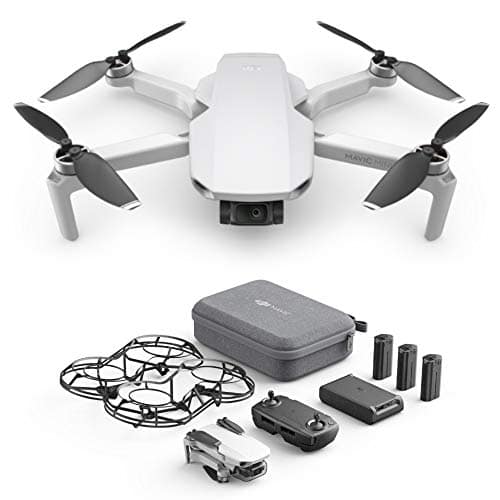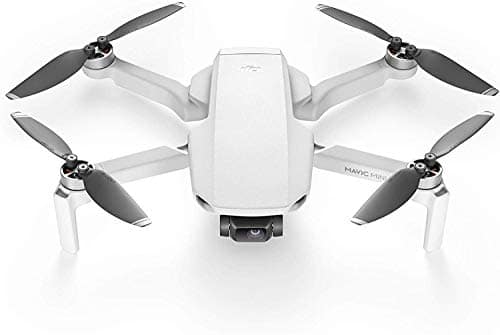DJI Mavic Mini – drone for your pocket
The DJI Mavic Mini is currently the smallest and most affordable copter in the range of the Chinese drone manufacturer. Despite a mechanical 3-axis gimbal and a 2.7K camera, the Mavic Mini weighs just 249 grams. Find out what else the small drone has to offer and whether the DJI Mavic Mini is currently one of the best mini drones in our detailed product review.
++ NEW: The DJI Mini 2 ++
Processing and design
The DJI Mavic Mini is available either individually or in the Fly More Combo with additional batteries and other accessories.
The tiny camera drone is 14 x 8.2 x 5.7 cm when folded and comes in a light gray color. The workmanship of the components used is of typical DJI high quality.
Unlike its big brother, the DJI Mavic 2, the Mavic Mini does not have LED lights on the arms, but it does have a status LED on the bottom, which also provides information about the battery charge level. Also on the back is a USB port and the slot for the microUSB memory card (max. 256 GB).

The battery is not part of the drone like in other DJI models, but is pushed into an extra compartment on the back. Since the battery is not visible, it does not have its own charge indicator. By the way, the battery is not a lithium-polymer battery (LiPo), but a lithium-ion battery.
Without the propeller guard, the mini drone weighs just 249 grams. With rotor protection (only included in the Fly More Combo) or simply with the included sticker, the weight increases to over 250 grams.
Unlike what you’re used to with other DJI drones, the DJI Mavic Mini doesn’t have quick-release propellers. The total of eight “half” rotors must first be bolted to the booms before ascending. To protect the camera gimbal system, the Mavic Mini has a Plexiglas protector that has to be removed before takeoff.
Technical data

The flight time of the Mavic Mini stated by the manufacturer is 30 minutes. In practice, however, this value is only achieved under optimal conditions and is therefore usually a few minutes less. Compared to other mini drones, however, this is a first-class value that almost no other drone in this price range achieves. For even longer flight times, we recommend purchasing another battery for the DJI Mini.
The maximum range of the Mavic Mini is 2.5 miles or 4 kilometers (FCC standard) in the US and 1.25 miles or 2 kilometers (CE standard) in Europe. Since drones may only be flown on sight in many countries, the range should therefore be more than sufficient for most drone pilots. It should also be noted that a high maximum range always goes hand in hand with a high transmission quality, which means that signal and video interruptions are much rarer.
The drone’s 2400 mAh Li-Ion battery accelerates it up to 29.2 mph (47 km/h) in Sport mode (“S” mode) and can be conveniently recharged on the go thanks to the included microUSB cable. A real charger, which can also be used as a power bank thanks to the USB output, is only included with the DJI Mavic Mini in the bundle (Fly More Combo).
In addition to the Sport and Standard modes, the Mavic Mini also has the so-called CineSmooth mode. If you activate this setting, the movements of the drone and gimbal slow down, so that even smoother camera movements are possible.
For the correct determination of its position, the Mavic Mini can rely on both GPS and the Russian GLONASS and therefore has enough satellites to choose from at any time. So that you can safely use the Mavic Air indoors, the drone also has a distance sensor and a ground camera. Through the two sensors, the drone independently holds the position even without GPS reception and can be navigated indoors without any problems.
The soundscape of the Mavic Mini is relatively pleasant compared to many other drones. Even in terms of volume and pitch, the Mavic Mini does not sound as loud and shrill as the DJI Mavic Air, for example.
The camera of the DJI Mavic Mini
The built-in camera has a 1/2.3″ CMOS sensor, which is also used in many smartphones. The drone records videos in up to 2.7K (2720 × 1530) at 30 fps. In Full HD, videos can be recorded at a maximum of 60 fps. The bit rate is 40 Mbit/s in each case. Your recordings are saved in MP4 format (H.264/MPEG-4 AVC).

The real highlight of the Mavic Mini’s camera is not the 2.7K resolution, but the mechanical 3-axis gimbal. This feature, which is otherwise only reserved for drones beyond 500 dollars, ensures exceptionally smooth recordings and camera movements. Here, no difference is noticeable even compared to the Mavic 2.
The camera’s field of view is 83°. Unfortunately, shutter speed and ISO cannot be adjusted manually in video recordings, but this is possible when taking photos. The Mavic Mini takes photos in up to 12 megapixels and saves them in JPEG format. RAW is unfortunately not available. The quality of the photos is quite convincing and the pictures do not have to hide behind those of much more expensive drones.
Maximum video resolutions
- 2.7K (2720 x 1530) @ 30 fps
- Full HD (1920 x 1080) @ 60 fps
- HD (1280 x 720) @ 60 fps
The recording modes
A total of four different shooting modes, the so-called QucickShots are available with the DJI Mavic Mini: Dronie, Rocket, Circling and Helix. Features like ActiveTrack or POI, as known from the DJI Mavic Air, are not available.
In Dronie mode, the Mavic Mini creates a short video of a selected object or person as it moves away on an imaginary line, slowly ascending.
In Rocket mode, the drone rises almost vertically above you or a selected object while the camera pans down and records.
In Circles and Helix modes, the drone flies around you in circles and spirals, respectively, creating a short video.
Another nice feature of the Mavic Mini is the ability to change the gimbal mode. This allows it to be adjusted to what is known as FPV mode if needed. In this configuration, the gimbal and camera tilt when flying curves, giving the impression that you are flying a model airplane and not a drone.

Scope of delivery
- DJI Mavic Mini
- Li-Ion battery (2400 mAh, 7.2 V)
- Controller (2600 mAh, 3.6 V)
- microUSB charging cable
- Connection cable (microUSB, USB-C, Lightning)
- 1 set of spare propellers
- Propeller protector
- Gimbal protector
- Screwdriver
- Spare screws
- Instruction manuals
When you choose the DJI Mavic Mini in the Fly More Combo, you also get a two-way multi-charger with QuickCharge function, two additional spare batteries (three batteries in total), a handy storage bag, and a propeller guard in addition to the standard package.

Conclusion
The DJI Mavic Mini is currently the smallest and most affordable DJI drone on the market. With a weight of less than 250 grams and its ultra-compact dimensions, it is the perfect drone for on the go.
In terms of both features and price, the DJI Mavic Mini ranks between the Mavic Air and Ryze Tello.
The mechanical 3-axis gimbal works great and is a real highlight for a drone under 500 dollars. Together with a video resolution of 2.7K at a maximum of 30 fps, it produces shake-free footage in excellent quality, which is otherwise only known from much more expensive drones.
All in all, the DJI Mavic Mini is an excellent entry-level drone that is convenient to carry around and produces top-notch photo and video footage. Due to its features and the comparatively low price, we can highly recommend the Mavic Mini and wish you a lot of fun flying, photographing and filming already now!




